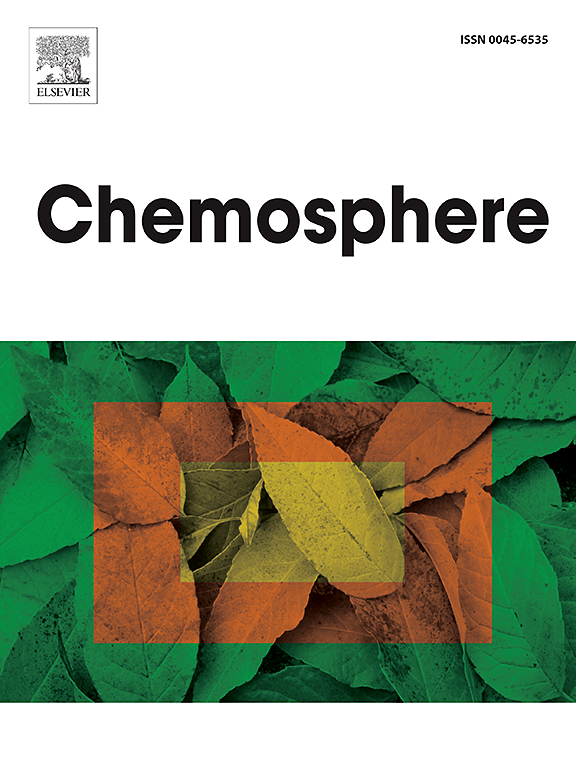Time-course detoxification of environmental metallic nanoparticles in human lung cells (A549)
IF 8.1
2区 环境科学与生态学
Q1 ENVIRONMENTAL SCIENCES
引用次数: 0
Abstract
Atmospheric particulate material (PM10), collected near to a metallurgical industrial area, caused internalisation of metallic nanoparticles. This is the first study of the bioavailability and detoxification pathway of metallic nanoparticles (NP) internalised into lung cells. Adenocarcinoma human alveolar epithelial lung cells (A549) were exposed to PM10 arising from a polluted area affected by smelting activity in Brazil (Vitória, ES). A time-course ultrastructural analysis (0, 3, 6, 9, 12 and 24h) was used to verify the internalisation process and its subsequent detoxification. The metal bioaccumulation, biochemical changes and cytotoxicity analyses were evaluated in lung cells after 24 h exposure to 0, 1, 5, 10, 20 and 40 μg PM10 mL-1. Time-course ultrastructural analysis showed that NP were internalised in both cytoplasm and nucleus after 1h exposure. Vesicles around internalised NP started forming after 3h; detoxification vesicles increased accumulating more NP between 6 and 12h exposure. Exocytosis was observed after 24h exposure. Five out of 28 analyzed metals (Al, Ti, Y, Fe and Ce) were bioaccumulated in the exposed cells. The emerging contaminants Ce, Y and Ti were mainly responsible for cytotoxicity effects. To our knowledge, this is the first record of the sequence of internalisation-toxicity, followed by physiological and biochemical responses, in lung cells exposed to atmospheric PM10 from a metallurgical area. This indicates the need for specific regulation of atmospheric PM from the smelting industry worldwide, considering the presence and toxic levels of emerging metallic contaminants (EMCs).

环境金属纳米颗粒在人肺细胞中的解毒作用(A549)
在冶金工业区附近收集的大气颗粒物(PM10)导致金属纳米颗粒内化。这是第一次研究金属纳米颗粒(NP)内化到肺细胞的生物利用度和解毒途径。腺癌人类肺泡上皮肺细胞(A549)暴露于受巴西冶炼活动影响的污染地区产生的PM10 (Vitória, ES)。时间过程的超微结构分析(0、3、6、9、12和24小时)用于验证内化过程及其随后的解毒作用。研究了暴露于0、1、5、10、20和40 μg PM10 mL-1 24 h后肺细胞的金属积累、生化变化和细胞毒性分析。时间过程超微结构分析显示,暴露1h后,NP在细胞质和细胞核内均被内化。3h后,内化NP周围开始形成囊泡;在暴露6和12h期间,解毒囊泡增加,积累了更多的NP。暴露24h后观察胞吐现象。28种分析金属中有5种(Al, Ti, Y, Fe和Ce)在暴露的细胞中有生物积累。新出现的污染物Ce、Y和Ti是细胞毒性作用的主要原因。据我们所知,这是首次记录了暴露于冶金地区大气PM10的肺细胞的内化毒性序列,随后是生理和生化反应。这表明,考虑到新兴金属污染物(EMCs)的存在和毒性水平,需要对全球冶炼行业的大气PM进行具体监管。
本文章由计算机程序翻译,如有差异,请以英文原文为准。
求助全文
约1分钟内获得全文
求助全文
来源期刊

Chemosphere
环境科学-环境科学
CiteScore
15.80
自引率
8.00%
发文量
4975
审稿时长
3.4 months
期刊介绍:
Chemosphere, being an international multidisciplinary journal, is dedicated to publishing original communications and review articles on chemicals in the environment. The scope covers a wide range of topics, including the identification, quantification, behavior, fate, toxicology, treatment, and remediation of chemicals in the bio-, hydro-, litho-, and atmosphere, ensuring the broad dissemination of research in this field.
 求助内容:
求助内容: 应助结果提醒方式:
应助结果提醒方式:


